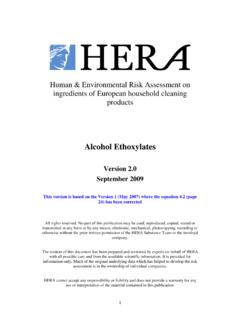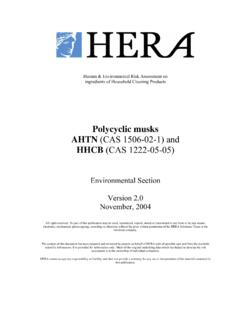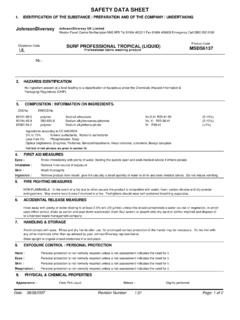Transcription of Phosphonates (CAS 6419-19-8; 2809-21-4; 15827 …
1 Human & Environmental Risk Assessment on ingredients of European household cleaning products Phosphonates (CAS 6419-19-8; 2809-21-4; 15827 -60-8) DRAFT All rights reserved. No part of this publication may be used, reproduced, copied, stored or transmitted in any form of by any means, electronic, mechanical, photocopying, recording or otherwise without the prior written permission of the HERA Substance Team or the involved company. The content of this document has been prepared and reviewed by experts on behalf of HERA with all possible care and from the available scientific information. It is provided for information only. HERA cannot accept any responsibility or liability and does not provide a warranty for any use or interpretation of the material contained in this publication. Page 1 6/09/2004 1.
2 CONTENTS 1. 2. EXECUTIVE 3. SUBSTANCE CAS No and Grouping Chemical structure and Physico-chemical Manufacturing route and Production/Volume Use applications 4. ENVIRONMENTAL Environmental Exposure Environmental Removal in sewage Monitoring PEC Environmental Effects PNEC Environmental Risk Characterisation Environmental Risk Characterisation 5000 Discussion and 5. Human health Consumer Product Consumer contact Consumer exposure Hazard Page 2 6/09/2004 Summary of the available toxicological Identification of Critical Determination of NOAEL or quantitative evaluation of Risk Margin of exposure Risk Summary and 6.
3 7. Contributors to the APPENDIX Substances covered under the HERA Risk Assessment on APPENDIX Phosphonate CAS numbers on worldwide Page 3 6/09/2004 2. EXECUTIVE SUMMARY Phosphonates are a class of chelating agents and scale inhibitors. Three acids, aminotris(methylene phosphonic acid) (ATMP), 1-hydroxyethylidene diphosphonic acid (HEDP) and diethylenetriamine penta(methylene phosphonic acid (DTPMP), have been assessed. They are used in household cleaning products, personal care products, institutional cleaners and industrial cleaning processes, and as water treatment additives in various applications.)
4 Uses in household cleaning products, the scope of HERA, include laundry detergents, hand dishwashing liquids, and various hard surface cleaners. The total volume of Phosphonates used in Europe is not known exactly, but estimated to be in the 10,000 50,000 ton/year range on an active acid basis of which 12,000 tonnes/year of the three assessed Phosphonates is used in household detergents and cleaning products (HERA, 2003). An extensive environmental data set is available for Phosphonates . On the environmental fate side, this includes biodegradation studies, simulation studies of removal in treatment systems, and a limited amount of field monitoring data. On the environmental effects side, acute as well as chronic single-species data are available. To determine the Predicted Environmental Concentration (PEC), the removal in wastewater treatment plants was estimated from laboratory simulations and the available field data.
5 Phosphonates do not significantly degrade in wastewater treatment plants, but are removed from the water by adsorption to sludge. The assessment of the fate in surface waters is conservative as known, but poorly understood removal mechanisms such as photodegradation have not been taken into account. The Predicted No-Effect Concentration (PNEC) was based on chronic ecotoxicity data, although the full three trophic levels have not been studied for all three acids concerned. The data did reveal a discrepancy for HEDP between to two chronic tests on daphnia. As for both tests the validity cannot be properly assessed, an assessment was made with each of the data separately. Retesting for this endpoint is being planned by the ACC Chemstar Panel on Phosphonic Acid Compounds, of which the producer companies are members.
6 It could be shown that the use of Phosphonates in HERA applications (household detergents and cleaning products) typically results in risk characterization ratios less than one, indicating no concern, for all environmental compartments. For HEDP there may be concern for the aquatic environment and for the sediment if the lowest PNEC is being confirmed by the future test results. An additional exposure scenario was included in this risk assessment, by assuming that 5000 ton of each phosphonate would be used and discharged in Europe for applications outside the scope of HERA. Using the same exposure and effects assessment approach, it is shown that the additional amount of Phosphonates does not change the conclusions of the HERA assessment. Page 4 6/09/2004 Consumers are exposed to the Phosphonates ATMP, HEDP and DTPMP through their presence in laundry and cleaning products mainly via the dermal route, but to some extend also via the oral and the inhalatory route.
7 A substantial amount of toxicological data and information in vivo and in vitro demonstrates that there is no evidence for ATMP, HEDP and DTPMP being genotoxic, mutagenic or carcinogenic. There is some conflicting data with regard to the mutagenicity of DTPMP, but the overall weight of the evidence suggests it is not mutagenic. There is also no evidence of reproductive toxicity or developmental effects in animals. The long-term toxicity of the acid or salt forms of the Phosphonates under review was evaluated in several subacute, subchronic and chronic toxicity studies. In the available chronic and subchronic oral toxicity studies, no adverse effects for ATMP, HEDP and DTPMP were observed at dose level of 500, 24 and 20 mg/kg/day respectively. To allow comparison of the consumer systemic exposure, the NOAELs for all three phosphonic acid compounds were corrected by the lowest systemic availability which was determined to be 2 % for the neutralized form of ATMP acid.
8 The systemic NOAELs for ATMP, HEDP and DTPMT were calculated to be 10, and mg/kg bw/d, respectively. The comparison of the aggregate exposure and the systemic NOAEL results in MOEs of 800, and > for DTPMP, HEDP and ATMP respectively. These margins of exposure are large enough to account for the inherent uncertainty and variability of the hazard database and inter and intra-species extrapolations, which are usually considered by a factor of 100. Under normal use conditions with direct skin contact ( , in hand laundering or in hand dishwashing) the consumer is exposed to detergent solutions containing % Phosphonates . At these concentration levels, Phosphonates are not irritating to eyes and do not alter the overall eye irritation profile of the cleaning product. Local dermal effects due to direct or indirect skin contact with phosphonate containing solutions in hand-washed laundry or hand dishwashing are not of concern because Phosphonates are not contact sensitizers and are not expected to be irritating to the skin at in-use concentrations.
9 In summary, the human health risk assessment has demonstrated that the use of ATMP, HEDP and DTPMP in household laundry and cleaning detergents is safe and does not cause concern with regard to consumer use. Page 5 6/09/2004 3. SUBSTANCE CHARACTERISATION Phosphonates are a group of chemicals used in laundry detergent products as functional agents, providing beneficial effects such as complexing, anti-redeposition, etc. They are also used in hard surface cleaners as chelating agents. The Phosphonates covered in this assessment are also included in the ICCA HPV programme. The draft documents (SIARs and SIDS packages) were submitted by the Chemstar Phosphonic Acid Compounds Panel (Chemstar PAC) to the UK as the sponsor country in the OECD in 2003 and reviewed at SIAM 18 (April 2004).
10 Data for this HERA assessment have been taken wherever possible from the SIARs. CAS No and Grouping information Phosphonates are multifunctional acids, which structurally have the phosphonic acid group PO3H2 in common. The phosphonate groups are placed on different backbones, often bound through a methylene group to amines (amine methylenephosphonates), or directly onto a carbon atom. Being multifunctional acids, Phosphonates will form salts or complexes of different composition, depending on the chemical composition and the pH of the environment. These substances are used primarily as acids and as sodium salts. Their behaviour in the body or in the environment does not depend on the presence of sodium as the counter ion. For the purpose of the HERA risk assessment, phosphonate salts are therefore being grouped under their respective parent acid (Table 1).













